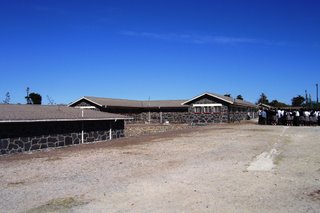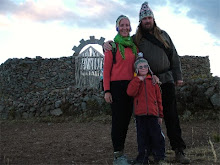An Island of Separation
April 23, 2006
Robben Island is the place where Nelson Mandela spent most of his time in incarceration. His crime was participating in an illegal political organization.

He was part of the leadership of the African National Congress (ANC) when he was arrested in 1963. As such he was kept in a special wing of the prison reserved for the leadership. The hope was that by separating the leaders from the others, no further planning could take place.
Robben Island is quite large. There is a thriving community there as well as the prison museum. It was originally used as a leper colony by the Portuguese. In those days the men were separated from the women so as to discourage pro-creation.
The first place we visited was the maximum security facility. It was reserved for political prisoners. At first they housed the political prisoners together with common criminals. They soon discovered, however that the political prisoners were recruiting the criminals into their ranks. This would not do.
There are eight wings. A and B were reserved for leadership. C was solitary confinement. D, E, F, and G were for the rank and file. The kitchen housed kitchen staff. A, B, and C had one person per cell while the rest had as many as eight to a cell. Toilets were buckets. There were no beds until 1979 when the Red Cross essentially pressed the issue. All meals were delivered to each wing. In this way the prisoners never had an opportunity to mix with anyone outside of their wing.


Coloureds and Asians were given shoes while the blacks were not. This was meant to create dissent amongst the incarcerated. Meals too were different. Blacks got less then the others, although they all got the same thing every day. There were no whites and no women within this prison.


Hard labor was the order of the day. There was a limestone quarry on the island that the prisoners worked by hand (remember the blacks had no shoes!). They dug the rock, broke it up, and hauled it to its final destination all under the watchful eyes of the guards who had orders to shoot to kill. A hand carved cave in the quarry served as the restroom, lunchroom, and school. Since education was at first forbidden, they would teach each other during lunch breaks using the sand and their fingers. They quarried the rock for the prison and built the sports fields for the wardens.



Pictures: Top; a door at the prison. Middle; the limestone cave, called university. Bottom;the prison
On the journey to the quarry we passed a house. Regretfully, I can’t remember the name of the fellow that was housed there. He too was part of the original leadership. When his sentence ended in Pretoria, legislation was passed to keep him locked up. He was moved to his own house on Robben Island. He was allowed to wear his own clothes and eat the same food as the guards. He was allowed no visitors. He was also forbidden to talk to anyone, even the guards. Eventually he was allowed visits from his family; for thirty minutes every six months. He developed throat problems from lack of use and was finally released after he went insane.
Another sobering day. It is difficult to fully condemn the South Africans knowing that our own history is not all that different. It is impossible, however to come away from this experience without being profoundly affected. Having entered this country knowing very little about their experience, I come away with a tremendous respect for the courage and determination of those who struggled against apartheid. I hope their future is brighter than their past.
MJR
Robben Island is the place where Nelson Mandela spent most of his time in incarceration. His crime was participating in an illegal political organization.

He was part of the leadership of the African National Congress (ANC) when he was arrested in 1963. As such he was kept in a special wing of the prison reserved for the leadership. The hope was that by separating the leaders from the others, no further planning could take place.
Robben Island is quite large. There is a thriving community there as well as the prison museum. It was originally used as a leper colony by the Portuguese. In those days the men were separated from the women so as to discourage pro-creation.
The first place we visited was the maximum security facility. It was reserved for political prisoners. At first they housed the political prisoners together with common criminals. They soon discovered, however that the political prisoners were recruiting the criminals into their ranks. This would not do.
There are eight wings. A and B were reserved for leadership. C was solitary confinement. D, E, F, and G were for the rank and file. The kitchen housed kitchen staff. A, B, and C had one person per cell while the rest had as many as eight to a cell. Toilets were buckets. There were no beds until 1979 when the Red Cross essentially pressed the issue. All meals were delivered to each wing. In this way the prisoners never had an opportunity to mix with anyone outside of their wing.


Coloureds and Asians were given shoes while the blacks were not. This was meant to create dissent amongst the incarcerated. Meals too were different. Blacks got less then the others, although they all got the same thing every day. There were no whites and no women within this prison.


Hard labor was the order of the day. There was a limestone quarry on the island that the prisoners worked by hand (remember the blacks had no shoes!). They dug the rock, broke it up, and hauled it to its final destination all under the watchful eyes of the guards who had orders to shoot to kill. A hand carved cave in the quarry served as the restroom, lunchroom, and school. Since education was at first forbidden, they would teach each other during lunch breaks using the sand and their fingers. They quarried the rock for the prison and built the sports fields for the wardens.



Pictures: Top; a door at the prison. Middle; the limestone cave, called university. Bottom;the prison
On the journey to the quarry we passed a house. Regretfully, I can’t remember the name of the fellow that was housed there. He too was part of the original leadership. When his sentence ended in Pretoria, legislation was passed to keep him locked up. He was moved to his own house on Robben Island. He was allowed to wear his own clothes and eat the same food as the guards. He was allowed no visitors. He was also forbidden to talk to anyone, even the guards. Eventually he was allowed visits from his family; for thirty minutes every six months. He developed throat problems from lack of use and was finally released after he went insane.
Another sobering day. It is difficult to fully condemn the South Africans knowing that our own history is not all that different. It is impossible, however to come away from this experience without being profoundly affected. Having entered this country knowing very little about their experience, I come away with a tremendous respect for the courage and determination of those who struggled against apartheid. I hope their future is brighter than their past.
MJR


0 Comments:
Post a Comment
<< Home